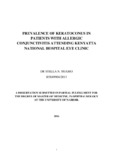| dc.contributor.author | Mugho, Stella N. | |
| dc.date.accessioned | 2016-11-18T08:33:21Z | |
| dc.date.available | 2016-11-18T08:33:21Z | |
| dc.date.issued | 2016 | |
| dc.identifier.uri | http://hdl.handle.net/11295/97551 | |
| dc.description.abstract | Objective: To determine the prevalence of keratoconus among patients with allergic conjunctivitis aged between 8 and 30 years, attending Kenyatta National Hospital eye clinic.
Methods: Patients already diagnosed with allergic conjunctivitis were requested to participate in the study. The patients were examined on the slit lamp, clinical signs of keratoconus were elicited, then keratometry and corneal topography was done on each of them. The social demographic and clinical data was captured in a questionnaire. The data collected was analysed using SPSS version 20.0. Descriptive analysis was done to determine means, frequencies and proportions of the various variables. The relationship between the demographic characteristics of the patients, the duration and severity of allergic conjunctivitis, with keratoconus was assessed.
Results: 246 eyes of 123 patients with allergic conjunctivitis were examined. Keratoconus prevalence was found to be 10.6% by clinical diagnosis, 14.6% by keratometry and 30.9% by topography. Majority of the patients with keratoconus were aged 10 to 14 years (42.1%). The male: female ratio of those with keratoconus was 1.9:1. Among those with keratoconus, 34.2% had moderate allergic conjunctivitis, and 42.1% had severe allergic conjunctivitis, which was statistically significant. Patients with allergy symptoms for more than 10 years had the highest proportion among those with keratoconus (42.1%).
Conclusion: Corneal topography diagnosed more patients, especially those with mild keratoconus despite having good vision. There was a strong association found between severe and long standing symptoms of allergic conjunctivitis with keratoconus. Corneal topography was highly recommended as part of the follow up investigations for all patients with allergic conjunctivitis, for early detection and management of keratoconus. This is especially so with newer forms of treatment like cross linking which has been shown to stop keratoconus progression, thus preserving vision. | en_US |
| dc.language.iso | en | en_US |
| dc.publisher | University of Nairobi | en_US |
| dc.rights | Attribution-NonCommercial-NoDerivs 3.0 United States | * |
| dc.rights.uri | http://creativecommons.org/licenses/by-nc-nd/3.0/us/ | * |
| dc.title | Prevalence of keratoconus in patients with allergic conjunctivitis attending Kenyatta National Hospital eye clinic | en_US |
| dc.type | Thesis | en_US |
| dc.description.department | a
Department of Psychiatry, University of Nairobi, ; bDepartment of Mental Health, School of Medicine,
Moi University, Eldoret, Kenya | |



